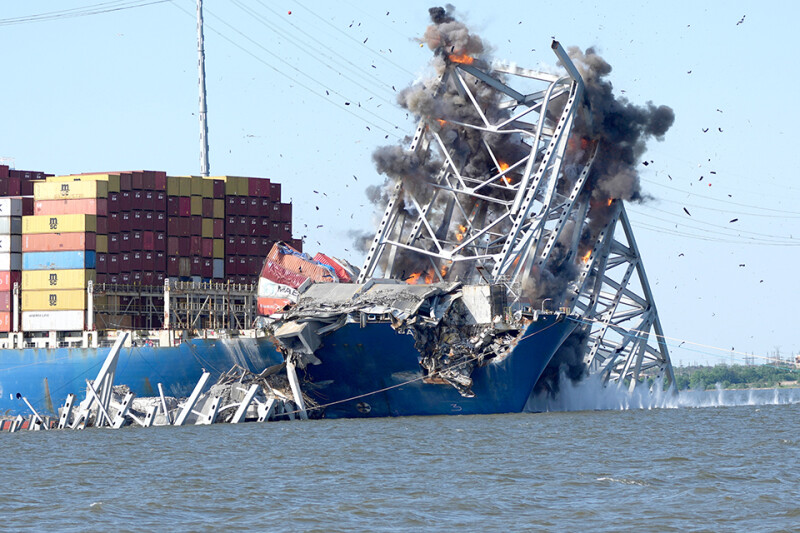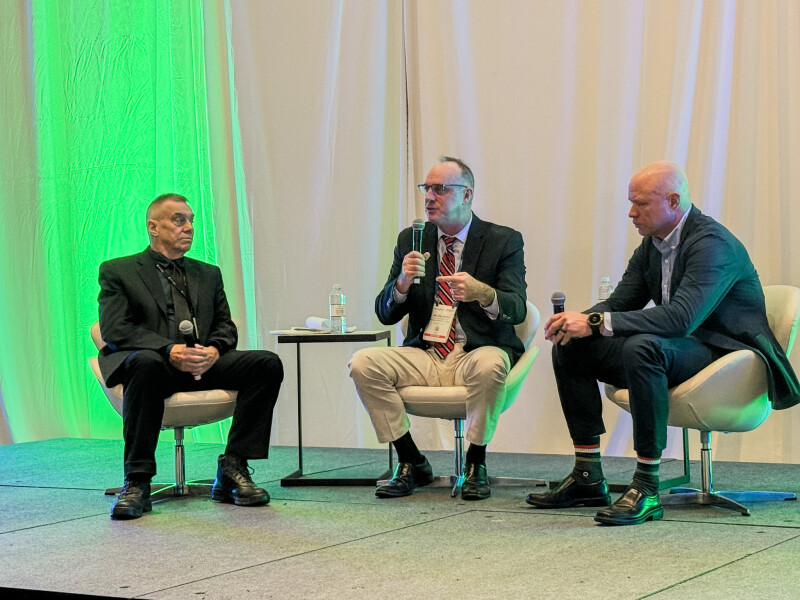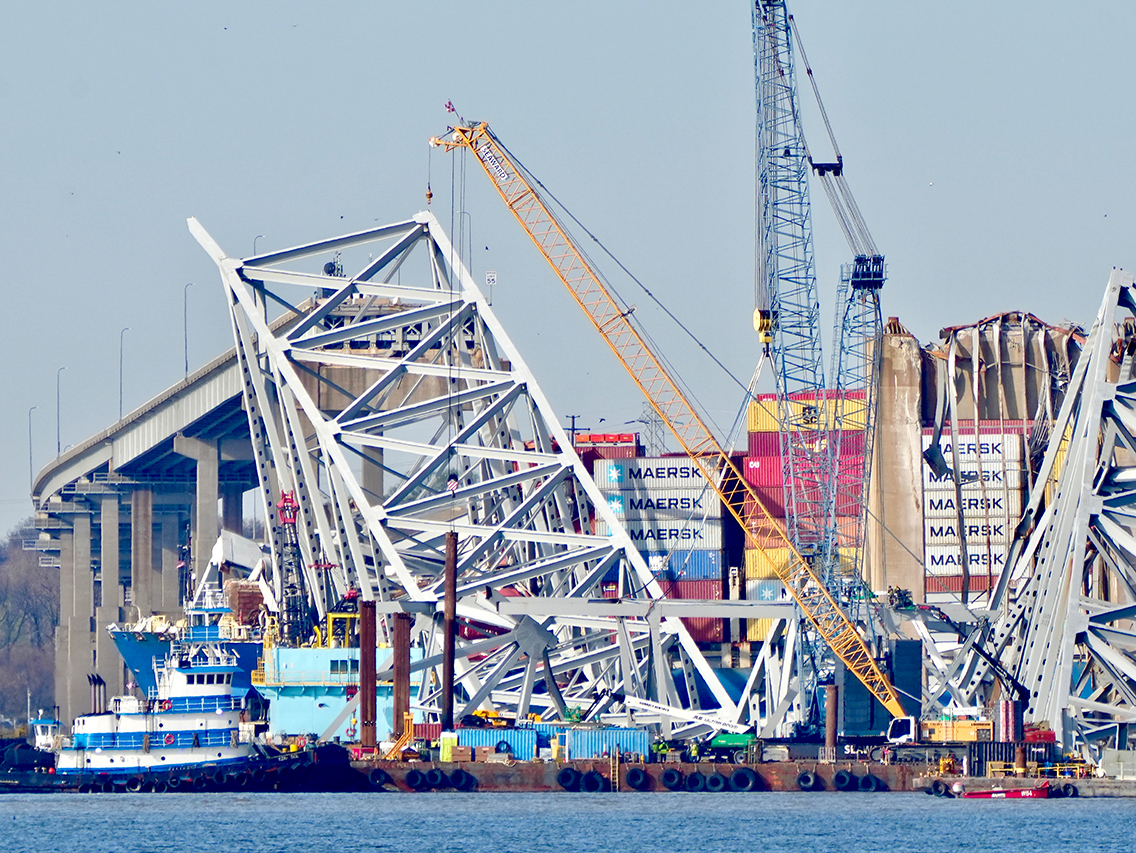The March 26 ship allision and catastrophic collapse of the Francis Scott Key Bridge in Baltimore was a stark revelation of U.S. port vulnerability.
When the 8,600’ continuous truss span came down, killing six workers, it was the end to a “sequence of poor decisions that are just about the hallmark of all disasters,” said Morgan Fanberg, CEO of Glosten, during a panel discussion Tuesday at the International WorkBoat Show in New Orleans.
But the weeks that followed were “a testament to all involved who got the Baltimore Harbor back up and running,” said Fanberg, whose Providence, R.I. marine architecture and engineering firm was involved in the recovery operation that had the main channel fully reopened by mid-June.

Outbound from Baltimore for Sri Lanka, the 948’ container ship Dali experienced electrical failures that triggered an automatic engine shutdown as it approached the bridge over the Patapsco River. The allision left the Dali pinned under the collapsed span, and some 50,000 tons of steel debris in the water. The six men who were killed had been working on the bridge when it collapsed.
A Coast Guard-led unified command formed to deal with the crisis, which closed the major Mid-Atlantic port. Within two days, Donjon Marine of Hillside, N.J. was involved and called on Glosten for its construction and salvage knowledge.
Two years before, the same kind of unified command response was brought into play after the containership Ever Forward grounded near the Chesapeake Bay bridge, recalled William Doyle, a past CEO of the Port of Baltimore and now executive director and CEO of the Dredging Contractors of America.
“That kind of coordination on command and control is critical,” said Doyle.
At the time of the Key Bridge collapse, the responders were somewhat lucky in one sense, he said. Cashman Dredging & Marine Contracting Co., Quincy, Mass., had recently finished dredging work in Chesapeake Bay and had equipment stacked at Baltimore that could be deployed almost immediately to help clear emergency channels around the bridge blockage.
The accident location was just about 1.5 miles from the old Bethlehem Steel plant, close enough to barge wreckage from the channel for stockpiling and ultimately sending out for recycling, said Doyle.
While the National Transportation Safety Board determined the Dali had experienced power problems before its early morning departure and the bridge allision around 1:30 a.m., the agency has yet to reach conclusions about the accident. An FBI investigation is likewise continuing.
The NTSB interim report pointed to maintenance problems and operating conditions of the ship as possibly having affected its electrical systems.
“I don’t doubt that vibration was an issue,” a typical problem in older vessels, said Glosten’s Fanberg.
Questions from the audience included how to enforce such “material conditions” on foreign flag vessels calling at U.S. ports.
“The pilots are doing their best” at due diligence, asking captains and crews about their vessels, said Fanberg. They would have had no way to know of the Dali’s problems before, he said.
“You assume that the ship is serviceable when it comes into a U.S. port,” said Doyle.
Other questions were raised about the adequacy of U.S port infrastructure in this era of post-Panamax, supersized containerships.
At Baltimore, “the infrastructure in place was built just 10 years after containerization came in,” said Doyle. On the other hand, there may already be upper practical limits, he added: “How much bigger are cruise ships going to get in the U.S.?”
On Oct. 24 Grace Ocean Private Limited and Synergy Marine Private Limited, Singaporean corporations that owned and operated the Dali, agreed to pay the U.S. government a $100 million settlement. The settlement money “will go to the U.S. Treasury and to the budgets of several federal agencies directly affected by the allision or involved in the response,” according to the Department of Justice.
Still to be resolved are legal claims from the state of Maryland, Baltimore city, the families of the highway workers who died, and other parties.

“You assume that ship is serviceable when it comes into a U.S. port,” said Doyle.
Other questions were raised about the adequacy of U.S port infrastructure in this era of post-Panamax, supersized containerships.
At Baltimore, “the infrastructure in place was built just 10 years after containerization came in,” said Doyle. On the other hand, there may already be upper practical limits, he added: “How much bigger are cruise ships going to get in the U.S.?”
Along with the need for a new bridge over Baltimore Harbor, Doyle foresees Congress will take the opportunity to tackle spending on other long-neglected spans.
“Congress is going to appropriate money to replace that bridge,” probably leading to “a big appropriations bill” in the 2025 legislative session, he predicted.
On Oct. 24 Grace Ocean Private Limited and Synergy Marine Private Limited, Singaporean corporations that owned and operated the Dali, agreed to pay the U.S. government a $100 settlement. The settlement money “will go to the U.S. Treasury and to the budgets of several federal agencies directly affected by the allision or involved in the response,” according to the Department of Justice. Still to be resolved are legal claims from the state of Maryland, Baltimore City, families of the highway workers who died, and others.




